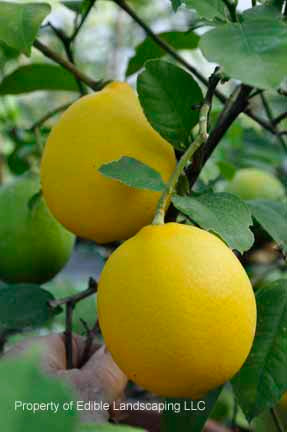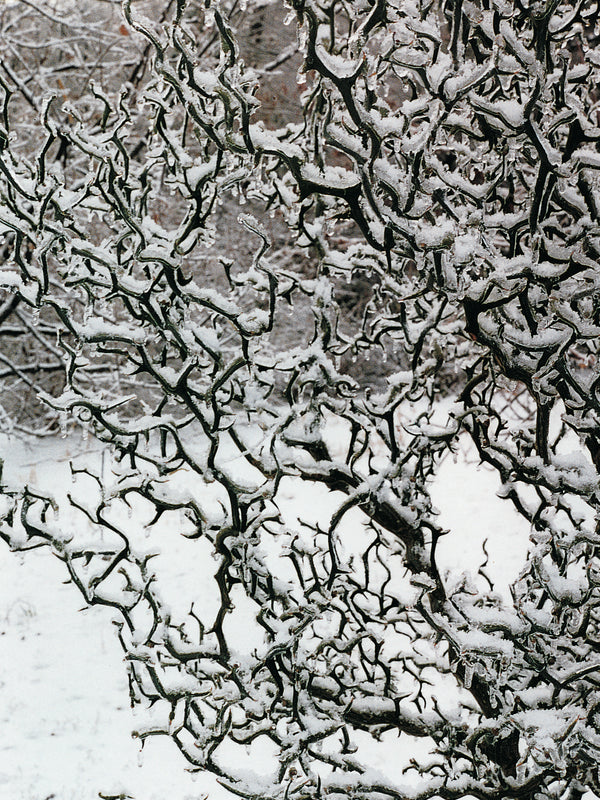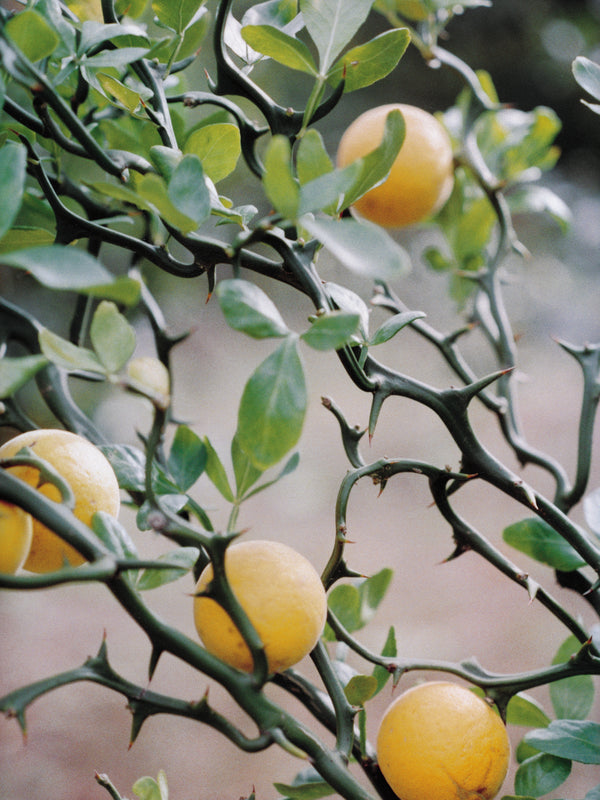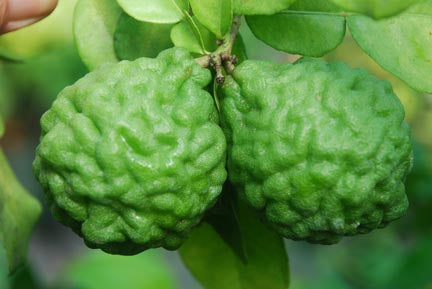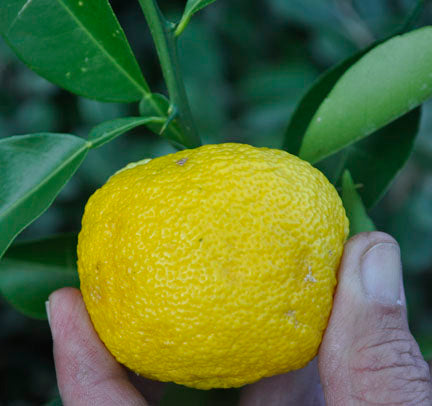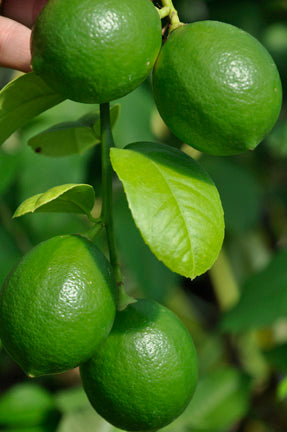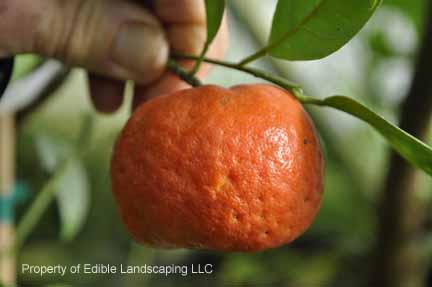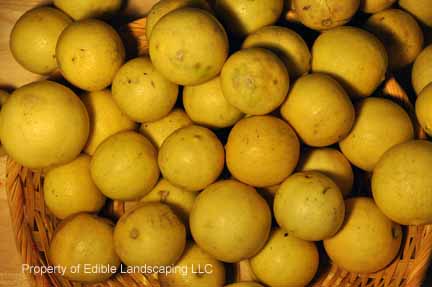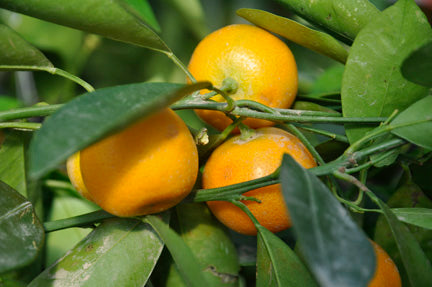Trifoliate Orange

Poncerus trifoliata
Can be grown outside in Zone 6. Prune lower growth back to encourage canopy. Golf-ball size fruits are best used for drinks and marmalade. The hardiest true citrus, though fruits are inferior to commonly known citrus, being resiny, seedy, and extremely tart. Can withstand below zero temperatures. Commonly used as a rootstock in northern citrus growing regions. Makes a very ornamental hedge which is impenetrable. Height 10'. Zones 6-9.
Due to import restrictions we are unable to ship Trifoliate Orange to CA, TX, PR, FL, AZ, Europe...

Hedge of Trifoliate Orange
Immature fruits and dried mature fruits are used medicinally in China. In southern Germany, fruit juice after two weeks' storage is used to make a flavoring syrup, the peel is candied and used as a spice, and is a source of pectin. The plant is much grown as an ornamental in cool areas of Europe, Asia and North America. In Brazil, it is valued as a protective hedge against animals and human trespassers. Seedlings are important in most citrus-growing areas as rootstocks for various Citrus and related species.
See the citrus care guide for; VA Wild Orange Marmalade
| Plant Characteristics | |
|---|---|
| Pest Resistance | Excellent |
| Disease Resistance | Excellent |
| Drought Tolerance | Very Good |
| Heat Tolerance | Excellent |
| Humidity Tolerance | Excellent |
| Sun Tolerance | Excellent |
| Wet Soil Tolerance | Fair |
| Shade Tolerance | Fair |
| No Spray | Excellent |
| Salt Tolerance | Poor |
| Fresh for Kids | Poor |
| Deer Resistance | Excellent |
| Thorns | Yes |
| Plant Type | Shrub |
| Soil Type | Adaptable |
| Edible Type | Fruit |
| Self Fertile | Yes |
| This information is accurate to the best of our knowledge, comments/opinions are always welcome | |
Planting citrus in a container
The most popular planter for a tree is 16 to 20 inches about a five gallon size pot. This provides room for many years of root growth. Smaller containers may be used to graduate the plant to a larger size. Citrus are unique, having root systems that fit readily into containers of average depth. If your plant becomes root bound and you don't want to graduate to a larger pot, remove 1/3 of the roots and cut back the top approximately 1/3. Add new soil and repot in the same container. This makes an attractive bushy dwarf tree. Do this only before new spring growth starts.
Soil mix
Use a light, well drained perennial mix such as Fafard #52. Compost, rock phosphate, greensand and lime are fine additives to basic mixes. These soil mixes should not be boggy. Small composted bark chips can also provide good drainage. The graft should be well above the desired soil level. In the winter indoors, attempt to keep soil temperatures @ 70 degrees F at night. If this is not feasible, a horticultural heating mat is advisable.
Watering
Allow one inch from soil to top of container for watering. Water when necessary. Don't let the tree dry out or be too wet. Good drainage is essential. In the ground, maintain a deep basin as wide as the tree. Citrus need a moist soil and air for roots. Again, avoid airless and soggy soil in the pots.
Planting citrus outside
In light, well drained soil, water established trees about once a week in dry weather. In heavy clay soils, the air spaces are tiny and excess water can't drain away rapidly. Water deeply every two to three weeks or more in dry weather. Allow time for it to drain and the surface to dry out but don't go so far as to let new growth wilt.
Fertilizing (potted and outside growing)
Use your own favorite all-purpose fertilizer or scatter balanced fertilizer as recommended on package only when plant is growing new leaves. Fish emulsion or other organics work fine. Nitrogen is the main requirement; use as directed and water it in. In a pot we use 12-month citrus fertilizer tablets. We recommend using Citrus tone. A sign of lack of fertilizer or poor drainage could be yellowing leaves. Citrus trees can benefit from minor nutrients (i.e. zinc, iron and manganese). These nutrients may also be added to the soil in chelate sequestrene form, scattered in the basin with other fertilizers. I have found magnesium deficiency more frequently in potted citrus; this can be remedied with @ 1 Tsp of Epsom salt for every 3 gallons of soil.
Suckering
Know where the graft is on your tree (if there is one). Remove all growth below the graft; it is worthless and takes vitality away from the top. This is especially true with younger trees. Suckers are generally very vigorous, thorny and have quite a different leaf than the top. Remove them as soon as seen.
Pruning
Little is required. This is one of the basic qualities of citrus. However, some trees may develop erratic branches; if so cut them back at any time. Given time, the trees round out and shape up naturally, without much pruning. To hurry this you can pinch off the tips of new growth.
Pest Control
Keep the tree free of pest. Pests distort leaves which retards growth and fruiting. There is a constant parade of new insecticides on the market. Rather than recommend any as being 'best' I will just tell you what we use: for aphids: We have found for indoor citrus the over the counter rubbing alcohol 65% dilution controls every citrus insect and is safe and easy to use. A Windex spray top will screw onto the rubbing alcohol bottle so it can be most convenient to use. Spray bottoms and tops of leaves. If the insect has laid eggs repeat in 5 days; mites have an 11 day egg to adult cycle. We are using Azitin a Neem oil extract and Botaniguard with success on our citrus. We spray about once per month and it's a great safe insecticide/fungicide. Mycotrol is another name for Botaniguard. Also for mites we use a mixture of hort oil, mycotrol and silmatric silicon.
Murphy's Oil Soap works as a great indoor insecticide and shines the leaves. The oil in the product smothers insects such as mites and the soap kills soft bodied insects such as aphids.
Growing Indoors and Under Glass
Too little is know about growing citrus indoors in non-citrus areas. Suggestions are: protect from freezing, give all sun light possible, rotate trees to light, keep pest free, florescent growing lights enhance plant growth, as do high pressure sodium and halide lights. We use a full spectrum light. Avoid sudden changes in environment. If moving from indoors to outdoors place trees in semi-shade to harden off.
Winter
In cold weather areas citrus should be brought indoors when the season starts changing to winter. A warm sunny spot is best. Some of the hardier types like Satsuma and Meyer Lemon can tolerate colder winter conditions. A customer in Virginia Beach, VA, for instance, over wintered her potted Satsuma in her garage. Cold sensitive varieties like Key Lime would probably drop their leaves for the duration of the winter months. The citrus can acclimate slowly to its new surrounding.
In colder northern climates citrus would suffer from abrupt changes in humidity. Citrus will grow in low humidity areas of the country, i.e. southern CA, AZ, but a house in Chicago may not have a humidity controlled environment. The moisture of the outside compared to the inside could differ greatly, especially if you bring your citrus in from outside late in the season and your heat is on day and night. One can buffer low humidity with misting the leaves of the plant. There is less leaf drop to healthy green leaves. A dry cleaning bag draped over an indoor citrus at night in the winter will prevent leaf loss from humidity drops in the home In colder areas the roots of the citrus won't be growing much. Any repotting would usually be done when spring growth starts. Early in my gardening experience I learned good soil is 40% air. Too wet or compacted potting soil leads to root rot, especially with cool soil temperatures.
Is good common sense not to fertilize while the plant is not growing. Usually by the end of January the days are longer and citrus will start to respond by blooming and unfolding new leaves. Citrus scent fills the room Spring has sprung indoors! All blooms will not turn to fruit. The plant will carry what it can ripen. Most citrus will bloom again in the summer or fall. If you're new at citrus growing, you'll probably pick your first fruit before its time. That's OK because it will probably taste like the store bought fruit you are used to Waiting holds its reward. The fruit only gets sweeter. For instance, our Washington Navel was color ripe around Christmas, but we did not pick it till mid February. Some of the Key Limes dropped off before I knew they were ripe, so experience is the best guide.
From a CT customer "My friends can't believe that I grow lemons, grapefruit, limes, etc. here in Ct. I love you guys!! "
Rootstock information
Carrizo is a hybrids of Washington navel orange and Poncirus trifoliata. The original crosses were made in the early 1900s by the United States Department of Agriculture with the intention of producing cold-tolerant scion varieties.
Carrizo is almost indistinguishable from Troyer and of the same parentage. Savage and Gardner (1965) have presented convincing evidence that Carrizo and Troyer are in fact a single clone, which originated as the zygotic seedling from a cross of Washington navel and trifoliate orange instead of two sister seedlings as had been assumed (Mortensen, 1954).
Carrizo use as rootstock: Mature trees are medium to large. Young trees on these stocks are vigorous and produce good crops of high quality fruits in their early years. Fully compatible with navel and Valencia orange varieties, but incompatible with Eureka lemon, forming a yellow ring at the bud-union. Crop regulation should be considered an essential management requirement for mandarin cultivars grown on these rootstocks.
Fruit quality is excellent, but there is a tendency for increased albedo breakdown in older trees. Fruit size is medium, with a thin, smooth rind. Juice and sugar content are high and acidity levels are medium to high. Fruit maturity is earlier than Poncirus trifoliata, Swingle citrumelo and Cleopatra mandarin but later than Rough lemon.
Advantages: Phytophthora tolerant, nematode tolerant, Tristeza tolerant, cold tolerant, highly polyembryonic, moderately vigorous.
Disadvantages: dislikes high pH soil, dislikes clay soil, sensitive to salinity and waterlogging, sensitive to calcareous soils, overgrows mandarin
scions.
Carrizo information from the Citrus Pages
Gather 40 of the small Poncirus trifoliata (Flying Dragon fruits work well also.) oranges. They will range in size from a big marble up to almost a billiards ball. If you get a bunch of the big ones cut back on the total number and if you find only the small ones you may need up to 50.
Peel the yellow part of the skin off 3/4th of the oranges with a vegetable peeler or a very sharp knife. Set this aside.
Ring the fruits one at a time and squeeze the juice out of the oranges. Do this in batches of 10 and clean the juicer after each batch. (I've not done experiments with it yet but this juice may be the base for a very effective glue.) The fruits are full of seeds and adding just a bit of water to the seed/juice/pulp mix twice helps separate out the seeds. Go on to the next batch only after fully separating the seeds from the juice and pulp from the preceding batch.
After you do all your batches you should have about 3 cups of juice and pulp. Set this aside and return to your peelings.
Add the peelings to a jar holding 2.5 cups of water and 1/8 teaspoon of baking soda. Bring to a boil and simmer for 10 minutes. Pour off about 2 cups of the water. Add the juice and pulp and simmer for 10 more minutes.
You may prepare your canning jars as you see fit. I do as follows. Put jars for 8 cups of marmalade into a big pot of water and bring them to a boil. Continue to let them boil very gently until the marmalade is ready to can. In a smaller pot do the same with the lids and the screw-on caps.
Measure 4 cups of sugar into a bowl then take 1/4 cup of that sugar and mix it with one package of low-sugar pectin in a small bowl.
Add enough water to the juice/pulp mixture to bring the volume to 5.5 cups and put it in a gallon pot for cooking. Add the sugar/pectin mixture from the small bowl and a 1/2 tablespoon of margarine. Bring this mixture to a rolling boil stirring constantly as it heats. Add the rest of the sugar and heat this till it again reaches a rolling boil. Boil for one more minute only.
Turn off all the heat and add the marmalade to the jars as fast as you can. Fill each jar to within 1/4 inch of the rim. If some marmalade gets on a jar rim wipe it off gently with a wet towel taking care not to touch the marmalade in the jar. Set the lid and tighten the screw cap down before going to the next jar. The lid will suck down and form a seal with the jar as the marmalade cools and shrinks. To test that the jars have all sealed, tap on the top when they are fully cool. The lids should NOT move down and make a noise when tapped. If one does, refrigerate it for immediate consumption. All the sealed jars should keep for months.

